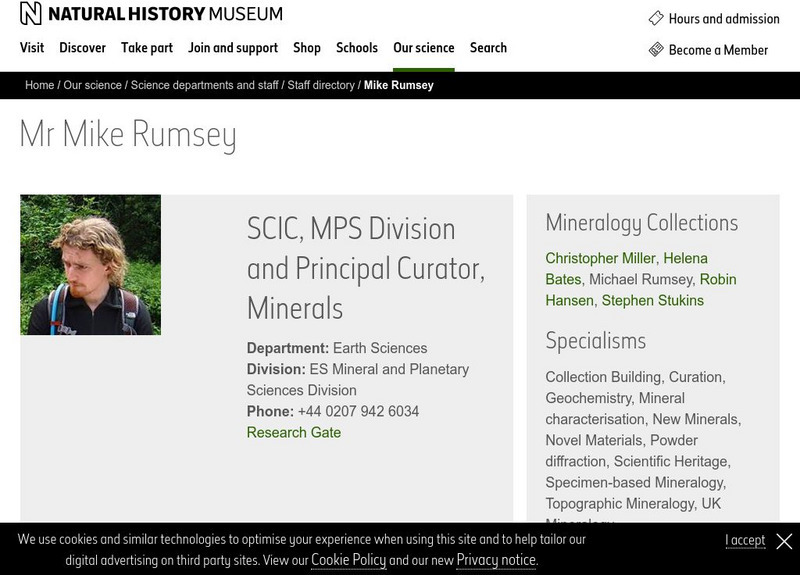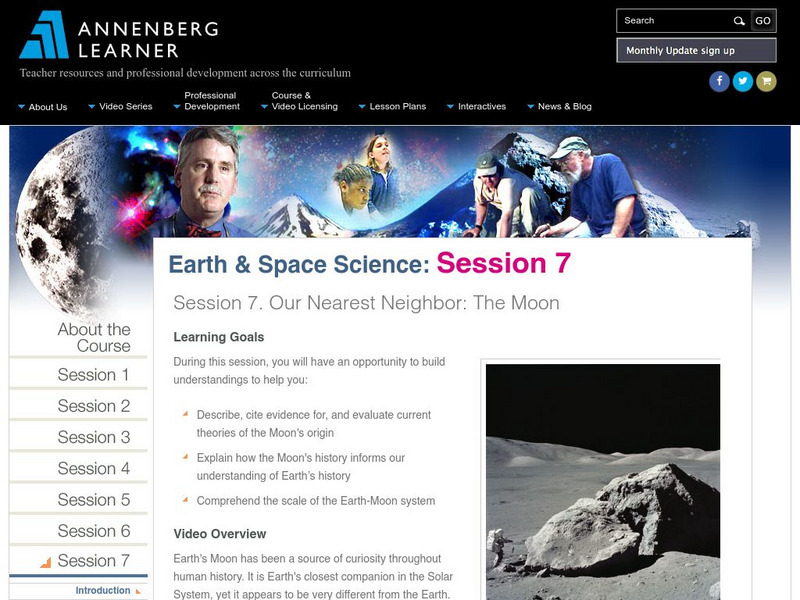Hi, what do you want to do?
Annenberg Foundation
Annenberg Learner: Earth and Space Science: When Continents Collide
Material to begin an exploration of plate tectonics and mountain formation. An hour-long video is accompanied by learning goals, an outline and overview, details on metamorphic rocks and mountain building, and ideas for teaching this...
Utah Education Network
Uen: The Dirt on Soil
After completing this lesson, students will understand the source and the process for the formation of soil, the different types of soil, and the components of soil.
PBS
Wnet: Thirteen: Savage Earth: Volcanoes Out of the Inferno
PBS's The Savage Earth provides online learning associated with the series including vivid pictures, animations, and detailed information about volcanoes. Learn about the formation and causes of volcanoes as well as the characteristics...
ClassFlow
Class Flow: How the Earth Is Built
[Free Registration/Login Required] This flipchart explores the ways the earth is built. It studies different types of rock formation and earth forms. Charts, graphs, and linking pages make this flipchart interactive
Other
Leeds University: Teaching Resources in Structural Geology
A large collection of resources for teaching structural geology. Information is sorted into topic headings, including basic principles of organization, basic structures (folds, faults, shear zones), virtual field trips, strain, geology...
Curated OER
National Park Service: Geology of Devil's Tower
Welcome to Devil's Tower National Park in Wyoming! This highly interactive website reveals the geological processes behind the formation of this unique natural structure.
University of Nebraska Omaha
University of Nebraska: Landforms
This resource provides information about the formation of the Grand Canyon to weathering processes is provided along with a link to photos of the Grand Canyon.
American Geosciences Institute
American Geosciences Institute: Earth Science Week: Seismic Mapping
Students become scientists, and learn about the usef of seismic technology to map patterns of rock formations below the surface of the Earth.
Energy4Me
Energy4me: Give It a Lift
Students will gain an overall picture of how oil can be recovered from a rock formation using artificial lifting equipment, such as a pumping unit.
Other
Caterpillar: Ground Rules: Mining Right for a Sustainable Future [Pdf]
This set of lesson plans was developed to accompany Ground Rules: Mining Right for a Sustainable Future, a documentary film created by Caterpillar and Science North. They introduce students to the various phases involved in mining,...
American Geosciences Institute
American Geosciences Institute: Fossils
Seven hands-on lessons module where students learn about fossils. These inquiry-based investigations explore how fossils form, properties of fossils, comparing fossils, how they show the age of the Earth, and what paleontologists do.
Untamed Science
Untamed Science: Biology: Evolution: How to Become a Fossil
Learn about what a fossil is, the different types that scientists use for study, and processes that form them. [2:57]
Georgia Department of Education
Ga Virtual Learning: Ap Environmental Science: Geology, Soil and Land Management
Students explore how Earth processes shape the land, and how important managing the land can be in response to these natural activities.
Discovery Education
Discovery Education: The Dirt on Soil
This interactive website explores the various soil layers and introduces you to the lifeforms that live in those soil layers.
Energy4Me
Energy4me: Core Sampling
Relate this to real-world drilling and why drill bits are used to churn up and break up rock in the sampling path. Explain to students that core sampling is one way that geologists determine the geologic formation of rocks and sediments...
Smithsonian Institution
National Museum of Natural History: Paleobiology: Green River Fossil Collections
Search the collection of 35,000 fossiliferous rocks found within the Green River Formation of Colorado and Utah. View some of these 50 million year old insect fossils in a linked slide show.
Smithsonian Institution
National Museum of Natural History: Paleobiology: Green River Insects
Interactive photo search of the collection of 35,000 fossiliferous rocks found within the Green River Formation of Colorado and Utah.
Natural History Museum
Natural History Museum: Mike Rumsey Mineralogist
This resource features a question and answer session in text format with Mike Rumsey, resident Mineralogist at the Natural History Museum. The questions are directed at understanding what it means to be a Mineralogist and to study rocks...
American Museum of Natural History
American Museum of Natural History: O Logy: The Amazing Mundo
Introduction, in comic strip format, to a selection of minerals and rocks that are used to make everyday objects, such as glass, aluminum foil, coins, and computer chips.
Annenberg Foundation
Annenberg Learner: Earth and Space Science: Our Nearest Neighbor: The Moon
Material to begin an exploration of the Moon, theories about its origin, and its history's relationship to our Earth's history. An hour-long video is accompanied by learning goals, an outline and overview, details on the Moon's movement,...
Australian Museum
Australian Museum: Structure of Volcanoes
A comprehensive site covering everything from volcanic structures to pyroclastic materials. View pictures of major volcanic landforms, and volcanic rocks.
Science Education Resource Center at Carleton College
Serc: Hawaiian Islands: Volcano Ages, Hotspots and Plate Motion
The ages of volcanic rocks are used to investigate speed of motion of the Pacific plate, to analyze the distinctive bend in the chain, and to consider the age data in the context of a hotspot model of formation.
Smithsonian Institution
Smithsonian American Art Museum: Winslow Homer
Winslow Homer is profiled at this site in a format that begins with a biographical sketch of his life. His works are then listed by appearance in the museum's database. Each work is presented in thumbnail format with brief information...
Indiana University
Indiana University Bloomington: Geo Notes: Salem Limestone: Its Origin [Pdf]
Describes the formation of the Salem Limestone during the Mississippian Period.
Other popular searches
- Sedimentary Rock Formation
- Metamorphic Rock Formation
- Rock Formation Caves
- Igneous Rock Formation
- Formation of Metamorphic Rock
- River Rock Formation
- El Captain Rock Formation
- Famous Rock Formations
- Rock Formation Petra
- Conglomerate Rock Formation
- Rock Formations Anticline
- Formation of Rock Types
























